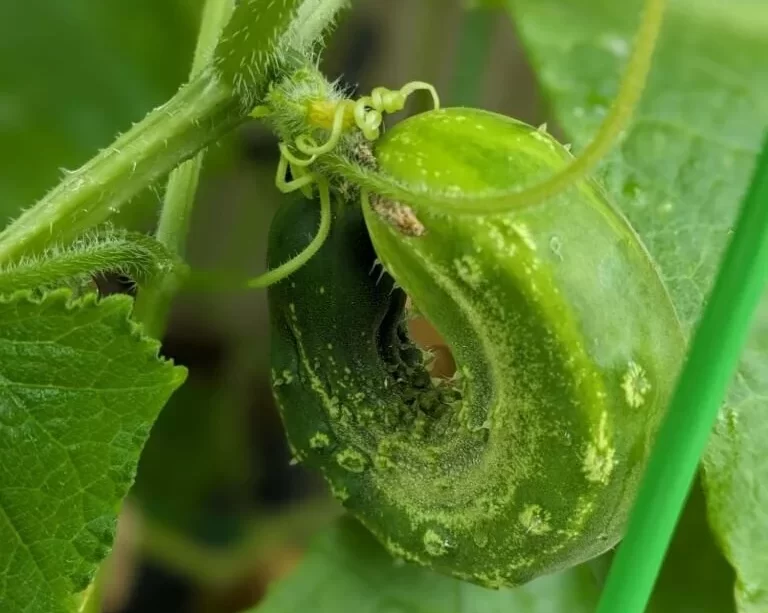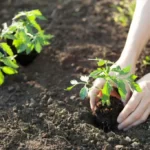Cucumbers are a beloved addition to many gardens, known for their crisp texture and refreshing taste. However, the joy of growing cucumbers can be tempered by the perplexing sight of curled or misshapen fruits. If you’ve ever found yourself wondering, “Why are my cucumbers curling?” you’re not alone. This article seeks to unravel the mystery behind this common issue that many gardeners face. We’ll explore the various factors that can cause cucumbers to curl and provide insights into how to prevent and address this problem, ensuring that your cucumber harvest is as straight and delicious as you desire.
- Optimal N-P-K Ratio: With an ideal ratio of 8-16-36, our fertilizer provides the perfect balance of nitrogen, phosphorus, and potassium to support vigorous plant growth, abundant flowering, and fruit production.
- Essential Micronutrients: Enriched with a potent blend of iron, manganese, zinc, copper, boron, and molybdenum, our fertilizer ensures your plants receive the precise nourishment they need for robust growth and optimal fruit development.
- Nutrient-Dense Produce: By supplying plants with an abundance of micronutrients, they are absorbed and stored within the leaves and fruits, resulting in produce that is not only delicious but also packed with essential vitamins and minerals.
- Versatile Application: Our fertilizer can be used for soil, hydroponic, and aeroponic cultivation methods, offering flexibility to growers in various settings. It can also be applied directly to the leaves as a foliar spray, allowing for efficient nutrient absorption and quick results.
- Promotes Nutrient Absorption: Our fertilizer encourages healthy root development, strengthens stems, and enhances fruit quality, ensuring a plentiful harvest season after season.
Environmental Factors
The environment in which cucumbers grow plays a pivotal role in their development, and when it comes to curling cucumbers, environmental factors are often a prime suspect. Temperature fluctuations, especially extreme heat or cold, can disrupt the growth of cucumber plants. High temperatures can cause the blossoms to drop prematurely, leading to curled cucumbers. On the other hand, cold snaps can slow down cucumber growth, resulting in irregular shapes. Inconsistent temperature and humidity levels can lead to stress for your cucumber plants, which is often reflected in their fruit.
Lack of Pollination
Pollination is a crucial step in the development of cucumbers, and a lack of it can be a significant cause of cucumber curling. Cucumbers, like many other fruits, require the transfer of pollen from male to female flowers to set fruit. When pollinators like bees and butterflies are scarce, or if cucumber plants are grown in a closed environment, pollination may not occur adequately. This can result in misshapen, curled cucumbers. To address this issue, consider planting flowers that attract pollinators nearby or even hand-pollinating your cucumber plants by transferring pollen with a soft brush or cotton swab. Ensuring proper pollination is a key step in preventing cucumber deformities.
Improper Watering
Watering is another critical factor that can influence the shape and quality of cucumber fruits. Both underwatering and overwatering can lead to cucumber curling. Inconsistent moisture levels in the soil can cause stress to the plants and result in misshapen cucumbers. When cucumber plants experience drought stress, they may produce curled or stunted fruits as a survival response. On the other hand, overwatering can lead to root rot and nutrient leaching, affecting the plant’s ability to grow straight cucumbers. Maintaining a consistent level of soil moisture through regular, deep watering is essential for healthy cucumber development. Be sure to water at the base of the plants and avoid wetting the foliage to prevent diseases.
Nutrient Deficiencies
Cucumbers, like all plants, require a balanced diet to thrive. Nutrient deficiencies, particularly in calcium, can lead to curled cucumbers. Calcium plays a vital role in cell wall development, and when cucumbers lack this essential nutrient, they may exhibit abnormal growth patterns. Inadequate calcium uptake can result from imbalanced soil pH, improper fertilization, or poor root development. To mitigate nutrient deficiencies, it’s essential to maintain soil pH within the ideal range for cucumber growth and provide appropriate fertilization with calcium-rich supplements when necessary. Ensuring that your cucumber plants have access to the right nutrients is a key step in promoting straight and healthy cucumber growth.
- New Liquid Fertilizer for: Cucumber (Cucumis) Zucchini (Cucurbita pepo)
- This food for plants belongs to the latest generation of fertilizers, for healthy leaves, strong formation, balanced rooting, many flowers and fruits.
- Very rapid effects, can be administered via the roots and as a foliar fertilizer. For 60-125 liters of ready to use liquid fertilizer
- Content: 250 ml, works as an economical concentrate. Simple dosage with the help of the bottle cap.
- The fertilizers from the GREEN24 PROFI LINE were developed by gardeners of various departments and were evolved and produced based on the current knowledge in the field of propagation and cultivation of plants.
Pests and Diseases
Cucumbers are not immune to the challenges posed by pests and diseases. Pests like cucumber beetles and aphids, as well as diseases such as cucumber mosaic virus, can negatively impact cucumber plants. When cucumbers are under attack, they may respond by producing misshapen or curled fruits as a defense mechanism. The damage caused by these intruders can disrupt normal growth patterns. To tackle this issue, practicing good garden hygiene, using pest-resistant varieties, and applying organic or chemical treatments when necessary can help protect your cucumbers from pest and disease-related curling.
Cucumber Varieties
It’s important to remember that not all cucumbers are created equal, and some varieties are naturally inclined to be curly. When selecting cucumber seeds or seedlings, consider the specific characteristics of the variety you choose. Some cucumber types, such as “Lemon” cucumbers or “Pickling” cucumbers, naturally produce curved or bumpy fruits. If straight cucumbers are your preference, opt for varieties like “Marketmore” or “Straight Eight” known for their uniform, straight shape. Be mindful of your choice, as it can influence the final appearance of your cucumber harvest.
Conclusion
Cucumber curling can be a perplexing issue for gardeners, but it is not an insurmountable one. By understanding the diverse factors that contribute to cucumber curling, such as environmental conditions, pollination, watering, nutrient levels, pests, and even cucumber varieties, you can take proactive steps to prevent and address this problem. The key to straight, healthy cucumbers lies in providing the right growing conditions, addressing plant stress, and selecting appropriate varieties. With the knowledge and solutions provided in this article, you can ensure that your cucumber harvest is a bountiful and beautifully straight one, satisfying your gardening aspirations and culinary desires.






